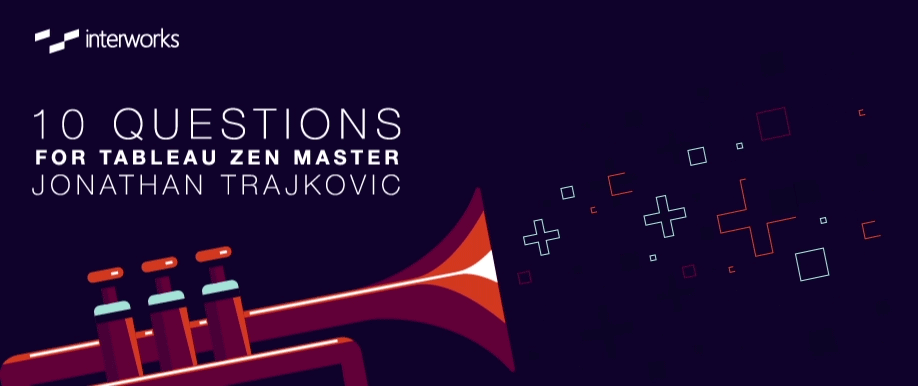10 Questions is an ongoing blog series in which Tableau Zen Master Dan Murray interviews some of the brightest folks in the world of data.

I met Jonathan at the Tableau Conference in Las Vegas last year. He has a background that includes science and business. He’s an engaging and talented fellow.
The Questions
Q: When and how did you start using Tableau?
Trajkovic: I started using Tableau four years ago when I was a student. In 2005, I chose to study chemistry, especially drug chemistry. That is why I graduated in 2010 with a master’s degree in organic chemistry. Unfortunately, after the first year of my PhD, I chose to change my way with another master’s degree in management. It is during this year that I discovered Tableau and my current company!
My boss asked two students and I to do a project about data visualization. The aim of the project was to do a complete presentation with a plan and a technical presentation … just like when you answer a request for proposals! The main point was that we chose Tableau as the perfect tool for data visualization.
We built a plan and a budget valuation. At the end of the presentation, I chose to show how Tableau is powerful for the technical demonstration, which lasted five minutes. I did my first dashboard that day! I spent almost two weeks to create it with open data about obesity. After the presentation, my current boss told me: “If you want to be an intern in my company come to see me!” Four years later, I am a data analyst and have a fascinating job!
Q: What is the most interesting project in which you have used Tableau?
Trajkovic: I am not sure that I can name just one project. This question triggers memories of several projects. From a technical point of view, the most interesting project was a financial one. I learned a lot of things about Tableau Desktop features with this project. In terms of business, the most interesting was about movie data for a famous company. This project was not very long but really interesting. But, if I have to choose just one project, it was with “French Post” about commercial monitoring. I think it was the most exciting challenge. I had to recreate a scoring tool using Tableau. I was proud of the solution that I delivered.
Q: You have a background in chemistry, a business degree and work as a data consultant. How has this background helped you with data visualization?
Trajkovic: My background in chemistry helps me to find a solution when an issue is in front of me. I think that my science training provided me with good habits and methods that help me be efficient. Moreover, in chemistry, you have to develop some skill to imagine a molecule in your mind. I think it helps me imagine solutions in my mind before doing it with Tableau.
On the other hand, my business degree gives me practical skills for understanding businesses. These skills are the most important when I do workshops with customers as it helps me to better understand their needs. My point of view is that the key when you are a data consultant is to understand quickly the needs and aim of a customer’s business.
Q: Do you use Tableau for discovery and analysis? What’s a good example of the value Tableau has provided?
Trajkovic: Yes, I always use Tableau for discovery. Tableau is a powerful tool because you can have an overview of all the data. For example, I check data quality with Tableau because I can count null values or mismatched values. I don’t think that it is the most powerful tool for this kind of work (there are many data quality tools in the market!), but it helps!
Moreover, I use Tableau to work with my colleagues on data warehouse projects. Tableau help us to analyze specifications for calculations and data sources. It can be used to address issues and fix mistakes with a quick analysis in Tableau. On the other hand, I use Tableau to analyze databases at the end of the project. Sometimes customers ask us to use Tableau to explore databases and create some interesting indicators. I think Tableau is a great tool to do this because you can quickly show the data in many ways.
Q: You are active on Tableau Public and have some nice dashboards and stories there. Which is your favorite Tableau Public visualization and why?
Trajkovic: It is hard to choose just one visualization because every day there are some really good dashboards created. But, if I have to choose one, I can name Adam E. McCann’s visualization about The Beatles. It was a really great piece of work: strong design, good analysis, great interactions.
I can name other authors that I like to follow, such as my friends Jeffrey Shaffer, Kelly Martin, Matt Francis but also Shine Pulikathara, Jewel Loree and Matt Chambers. They all do amazing work.
On the other hand, if I have to choose a visualization I created, I can tell the last one about the Paris attack is the best because it was a strong and emotional topic. I think I chose a good design to show the mood during these sad days.
Q: How do you continue to improve your Tableau skills. Are there blogs you read? Social media accounts you follow?
Trajkovic: I try to follow by Twitter feed what is done among Tableau Community actors. I think it is the best way to learn and share. Every day, I can find an interesting article or blog post. It is like an endless source of knowledge! About blogs, I follow Joshua Milligan, Jeffrey Shaffer, Jonathan Drummey and Robert Rouse, especially. I also follow Tableau’s feed of the tableau.com blog and Tableau Public blog. It is easy to find interesting posts and great visualizations.
Q: How has the Paris Tableau community changed over the past few years?
Trajkovic: It is a slow but solid development. I’ve only known Tableau for four years. In 2012, a Tableau User Group was created, which allows people to share knowledge and experience. Tableau Support provides answers in French and Tableau Public has several French authors. I think most of the beautiful things are coming! Last year, after the Tableau 9.0 roadshow in Paris, I saw that Tableau is really growing in France. Indeed, two years ago, only 60 people were present. For the 9.0 roadshow this year, there were more than 200 people!
Q: Who are your best Tableau friends in France and why?
Trajkovic: Gaëlle Périat, Geoffrey Felix and Damien Lesage. We are all involved in the Tableau User Group Paris organization. I know that I can share a lot of things about Tableau with them, such as release and beta feedback, roadmap, tips, etc. It is really interesting because I can talk about various topic with each of them. If I want to discuss Tableau Server, I can do it with Damien, who is really skilled. About visualizations, why not have a talk with Gaëlle Périat? Ideas about business? Let’s have a talk with Geoffrey Felix.
Q: What are some of the Tableau visualizations you’ve seen over the past year that you admire?
Trajkovic: One of my favorites is “Bird Strike Redoux” by Kelly Martin. I think it is a really amazing piece of work. All I would love to do is here: design, organization, description, interactivity, efficiency. Another one is “Music Major – Data Miner” by Jeffrey Shaffer. He was one of my challengers during Iron Viz 2014. His work is really great. The Sankey diagram was just amazing the day I discovered it! The last one I want to name is Shine Pulikathara with his Iron Viz 2015 work. It was really impressive to create this great piece of work in only 20 minutes. Unfortunately, I missed the live show. But WOW, how can he do it so efficiently in this short time?
Q: You’ve played the trumpet for over 20 years. Has being a musician helped you be a better data consultant?
Trajkovic: Being a musician helps me to speak in front of audiences because I’ve done it for several years before I started using Tableau. It is not so easy to drive a workshop if you are not accustomed to being the center of attention. Moreover, I think it helps me to listen more accurately. When you are a musician in a band or as a soloist, you have to listen what is going on around you. If you don’t do it, it could be disastrous. This skill helps me to understand customers more accurately during workshops. Maybe can we ask Jeffrey Shaffer about it? 🙂
Discover More Interviews
Want to read more insightful interviews like this one? Then you’ll love our 10 Questions blog series. Check out the full list of interviews here, and stay tuned for new additions.
Need Help? Let Us Know!
There you have it. If you need help with your data infrastructure or Tableau, we have the experience, skill, and knowledge to insure your success. Contact us today to learn more.
If you’re in college and think you might want to get into this game, head to our Careers page and apply for one of our open jobs. We’d love to hear from you.

